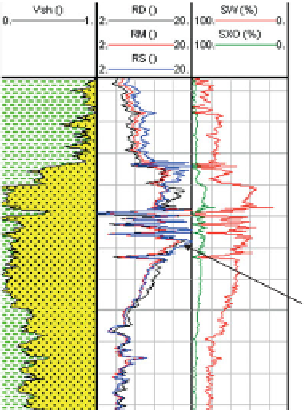Geology Reference
In-Depth Information
s
ρ
1
ρ
2
associated with porosity estimation from the density
log is the determination of the fluid parameters in the
zone in which virgin fluids have been displaced by
mud filtrate (i.e. the invaded zone). Typically, inva-
sion is indicated by differences in the shallow,
medium and deep resistivities (
Fig. 8.52
).
Invasion is a complex process resulting from the
movement of drilling mud filtrate into the borehole
wall under pressure. Invasion proceeds until mudcake
builds up and the process stops. The depth of invasion
in high-porosity rocks can be limited by rapid mud-
cake formation, whereas in moderate-porosity rocks,
particularly if the hole has been left open for a long
time or has been drilled over-balanced (i.e. with a
mud weight significantly higher than that required
to balance the formation pressure), then invasion
can be extensive.
The fluid density of the invaded zone depends
on a number of factors including the saturation in
the invaded zone, the fluid density of mud filtrate
and the density of the virgin formation fluids.
In many instances invaded zone fluid parameter
estimation may involve a certain degree of trial
and error. Core porosities (total porosity calculated
in the laboratory) can be invaluable to help con-
strain effective fluid densities for porosity estima-
tion. Forcing a regression line from the mineral
point through density
ϕ
ϕ
R
2
1
ρ
2
V
p2
¼
V
p1
2
K
fl1
K
fl2
,
ð
8
:
42
Þ
where
ρ ¼
bulk density, K
fl
¼
fluid bulk modulus,
ϕ
¼
porosity,
critical porosity and 1 and 2 refer to
initial (hydrocarbon bearing) and substituted (brine
bearing) values respectively. In this case the appropri-
ate
ϕ
R
¼
ϕ
R
is determined by optimization. After fluid sub-
stitution to brine, V
s
prediction and derivation of
Gassmann dry rock parameters, V
p
can be predicted
and compared to the original
log value. The final
choice of
ϕ
R
can be chosen by minimising the error
in V
p
prediction.
8.4.4 Borehole invasion
The invasion of filtrate into the borehole wall has the
potential to alter density and sonic log measurements
(e.g. Han and Batzle,
1999
; Walls and Carr,
2001
).
This can be a significant problem in situations where
the reflectivity is subtle (e.g. Class IIp type situations).
Making corrections for these effects can make a dif-
ference to the scaling of extracted wavelets (Vasquez
et al.,
2004
). Whilst correction for invasion is usually
necessary for density logs, it is questionable whether
sonic logs need to be corrected. The interpreter needs
to approach the issue with care owing to the fact that
there are a large number of potential variables and the
invasion
core porosity data to 100%
porosity allows an estimate of the fluid density
(
Fig. 8.53
). Of course much depends on the nature
of the dataset as to the perceived accuracy of the
extrapolation.
-
correction
solution
is
often
under-
constrained.
Owing to the fact that the zone of investigation of
the density log is very shallow, the key problem
Uninvaded zone
Figure 8.52
Borehole invasion
indicated by differences in the deep,
medium and shallow reading resistivity
logs.
Hydrocarbon
Formation water
near borehole schematic
Grey = mudcake
Slant hash = Invaded zone
Horizontal hash =Transition zone
Green = Uninvaded zone
Hydrocarbon
Mud filtrate
188
Invaded zone


























































